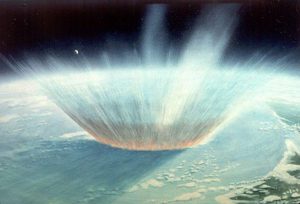17 January 2017
How darkness and cold killed the dinosaurs
Posted by Lauren Lipuma

Roughly 66 million years ago an asteroid slammed into the Yucatan peninsula. New research shows tiny droplets of sulfuric acid formed high up in the air after the impact, shown here in an illustration, cooling Earth’s climate for years to come.
Credit: NASA.
Climate scientists have now reconstructed how tiny droplets of sulfuric acid formed high up in the air after a large asteroid impact 66 million years ago. In a new study published in Geophysical Research Letters, a journal of the American Geophysical Union, researchers report that the sulfuric acid blocked sunlight for several years and had a profound influence on life on Earth. Plants died and many animals went extinct, including the dinosaurs.
Previous theories of this mass extinction focused on the shorter-lived dust ejected by the impact. But computer simulations in the new study show the droplets of sulfuric acid resulted in long-lasting cooling and were a likely contributor to the death of land-living dinosaurs. An additional kill mechanism might have been a vigorous mixing of the oceans, caused by the surface cooling, severely disturbing marine ecosystems, according to the study’s authors.
“The big chill following the impact of the asteroid that formed the Chicxulub crater in Mexico is a turning point in Earth history,” said Julia Brugger, a climate scientist at the Potsdam Institute for Climate Impact Research (PIK) in Potsdam, Germany and lead author of the new study. “We can now contribute new insights for understanding the much debated ultimate cause for the demise of the dinosaurs at the end of the Cretaceous era.”
To investigate impact’s effects on life, Brugger and her team used a specific kind of computer simulation normally applied in different contexts: a climate model coupling atmosphere, ocean and sea ice. The simulation showed sulfur- bearing gases that evaporated from the violent asteroid impact Earth’s surface were the main factor for blocking the sunlight and cooling down Earth.
In the tropics, annual mean temperature fell from 27 degrees Celsius (81 degrees Fahrenheit) to 5 degrees Celsius (41 degrees Fahrenheit), according to the new study.
“It became cold, I mean, really cold,” Brugger said. Global annual mean surface air temperature dropped by at least 26 degrees Celsius (47 degrees Fahrenheit). After the impact, the average annual temperature was below freezing for about 3 years and the polar ice caps expanded.
“The long-term cooling caused by the sulfate aerosols was much more important for the mass extinction than the dust that stays in the atmosphere for only a relatively short time,” said Georg Feulnerm, a climate scientist at PIK and co-author of the study. “It was also more important than local events like the extreme heat close to the impact, wildfires or tsunamis.”
It took Earth’s climate about 30 years to recover, the scientists found.
In addition, ocean circulation became disturbed. Surface waters cooled down, becoming denser and hence heavier. While these cooler water masses sank into the depths, warmer water from deeper ocean layers rose to the surface, carrying nutrients that likely led to massive blooms of algae. It is conceivable these algal blooms produced toxic substances, further affecting life at the coasts, according to the researchers. In any case, marine ecosystems were severely shaken up, and this likely contributed to the extinction of species in the oceans, like the ammonites.
The study of Earth’s past also shows that efforts to study future threats by asteroids have more than just academic interest, according to the researchers.
“It is fascinating to see how evolution is partly driven by an accident like an asteroid’s impact—mass extinctions show that life on Earth is vulnerable,” Feulner said. “It also illustrates how important the climate is for all lifeforms on our planet. Ironically today, the most immediate threat is not from natural cooling but from human-made global warming.”
—This post originally appeared as a press release on the PIK website.










 GeoSpace is a blog on Earth and space science, managed by AGU’s Public Information staff. The blog features posts by AGU writers and guest contributors on all sorts of relevant science topics, but with a focus on new research and geo and space sciences-related stories that are currently in the news.
GeoSpace is a blog on Earth and space science, managed by AGU’s Public Information staff. The blog features posts by AGU writers and guest contributors on all sorts of relevant science topics, but with a focus on new research and geo and space sciences-related stories that are currently in the news.